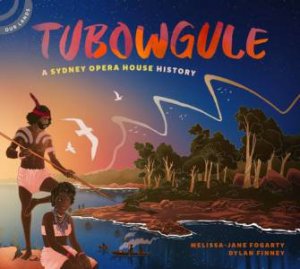Tubowgule: A Sydney Opera House history by Melissa-Jane Fogarty. Illus. by Dylan Finney

Centuries, indeed, millennia, before it became one of Australia's most iconic tourist attractions where people gather to share and tell stories, sing and hear music and stories and enjoy dance, drama and other cultural experiences, it was a place for the Gadi people to do exactly the same sorts of things. Known as Tubowgule - tube-uh-gahlee - which means "where the knowledge waters meet" because the fresh waters of the creeks mixed with the salty waters of the oceans making it a place of rich resources, the Gadi people would congregate to enrich and replenish their physical, mental, emotional and spiritual well-being.
While millions of Australians and international visitors may only know it for Utzon's creation built from playing with sailboats and orange peels, watching swans and collecting seashells, the Sydney Opera House has a history that disappears into the far distance of time, and which is brought to life in this striking book, the first in a series that explores the indigenous history of some of Australia's iconic landmarks.
Even though British colonisation brought about many changes to the use of the land, all of which are mapped out in double page spreads and a final-page timeline, the presence of the First Nations people continued, explained in sidebars that show how purpose and perspectives changed until they turned full circle, when in 2007 it was added to the UNESCO World Heritage List and Ben Blakeney, an Aboriginal actor and descendent of Banalung, officially welcomed people to the House.
Described by the National Indigenous Times as "a rich and inclusive exploration of the land beneath one of Australia's most famous landmarks" it offers younger readers an insight not just into the story of the Opera House itself, but helps them understand that, like so many other locations they are familiar with, places have stories to tell that can bring them alive and make them relevant and meaningful. From the front cover and endpapers which provide a poignant sneak peak of what is to follow, there is history immersed in every word and illustration and teachers' notes encourage the exploration of these, particularly for those in the middle to upper primary grades. Even though the building itself might not be something non-Sydney readers are as familiar with, nevertheless there are significant points that are part of the nation's more recent history which can be investigated and perhaps even compared to the history of their own region, while some might like to investigate a local landmark that could be the subject of another in the series.
Another in a growing collection of narrative non fiction works which offer insight and understanding of First Nations Peoples that can only take us forward on the journey together.
Themes: Sydney Opera House, Aboriginal peoples.
Barbara Braxton